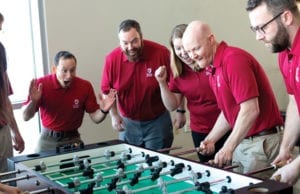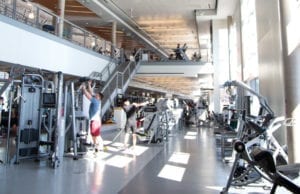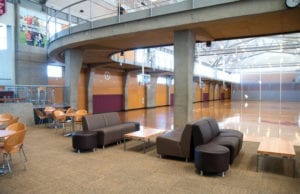Since opening in 2001, the Student Recreation Center at Washington State University (WSU) has seen over 12 million uses.
But, while the structure is located on the Pullman campus, serving the approximately 20,000 students, University Recreation (UREC) is extending its reach much further.
“WSU as a whole has really made a concerted effort to engage the smaller branch campuses and the online students to really try and create more of a true college experience for them,” said Jeff Elbracht, the director of facilities.
The idea of “One WSU” has taken root in the department as they strive to seriously address the present issues. While not all the branches have a recreation program or department — and while some students just exist online — it’s required Elbracht and the team to engage students in different ways than they are used to.

The online part allows them to reach WSU’s global campus students. Receiving student fees from the global campus student government, Greene said the global campus asked for programming related to well-being. UFit 4.0 helps meet that request. And so does offering a few well-being programs online, including webinars, special events, an educational website and a gym membership reimbursement program.
Ultimately, it’s about trying to be a resource for other campuses and those online. “Having students realize this is something we’re trying to encourage for their college experience, we give them these online resources and videos they can then take and implement themselves,” said Elbracht.
Both Elbracht and Greene have realized how every interaction with students matters. So, a lot of effort goes into making those interactions great. For starters, it begins with marketing the programs.
Kelli Schramm, the marketing and communications coordinator, said they always work to keep the students in mind when building a program’s campaign. They ask how can students benefit, and what fear might keep them away? “We are looking for perceived barriers from the participant’s point of view,” she said. “Our goal is to help remove those barriers and provide access. Students should be trying new things and stepping out of their comfort zone; it’s how they learn who they are and find what they are passionate about.”
From there, it’s overcoming challenges. For example, Schramm said they provide many 
Photos and videos are useful resources for the marketing team. “When we decide to create a video for promotion, we make sure the video serves as a useful resource to students. The video should accomplish something a social media post or flyer can’t,” said Schramm. “For example, we’re currently in the process of creating an exercise database dedicated to showing students how to safely perform all types of workouts; we’ve filmed demonstration videos for around 750 different workouts. We want this site to be a resource for students to help them build and learn new workouts, study correct form, and feel confident they’re performing the movements safely and correctly.”
Beyond marketing the program, the student staff play a large role in interaction with WSU’s users. “While we provide an extensive amount of services, education of students in skills that will be beneficial for the rest of their life is the most important thing we provide,” said Elbracht.
It all comes down to preparing students for the real world. The department’s learning outcomes for students are professionalism, leadership, well-being and inclusivity.
At the start of every school year, all the campus recreation student staff come together — about 250 — for breakout sessions. They get the chance to have discussions with one another about customer service and consider how a situation might be handled in the weightroom versus on the intramural field. This consolidated approach exposes students to new things.
Raimonte’ Butler, a membership attendant at WSU, said campus recreation at the university is stimulating, rewarding and engaging. “I enjoy the atmosphere,” said Butler. “I appreciate how our staff aligns themselves with UREC values, which are excellence, sustainability, inclusivity, discovery and play, creating a warm and genuine environment for not only our staff, but patrons as well.”

Even the way students interact socially has changed. Elbracht explained they are offering shorter programs, reorganized space to allow for more privacy as students workout, etc. “One of the things we’re really trying to encourage is creating a certain level of comfort that doesn’t deter those individuals from being willing to come out,” he said.
As the campus recreation department for WSU, they want to reach and serve everyone in order to become one. “We have the opportunity to make someone’s day and help them feel like part of the campus community. We can be seen as a student’s happy place, somewhere to destress, their home away from home. It’s up to us to make sure all students feel this way,” said Greene. “Every visit, every advertisement, every interaction matters.”










